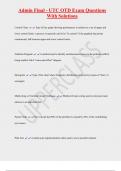-
1. Exam (elaborations) - Otd 306 final exam questions with solutions
-
2. Exam (elaborations) - Otd 306: quiz 1 exam questions with solutions
-
3. Exam (elaborations) - Otd 306 quiz review questions with solutions
-
4. Exam (elaborations) - Admin final - utc otd exam questions with solutions
-
5. Exam (elaborations) - Otd 215- medical terminology chapter 1 exam questions with solutions
-
6. Exam (elaborations) - Otd 230 quiz 3 exam questions with solutions
-
7. Exam (elaborations) - Otd 302 exam ii practice questions with solutions
-
8. Exam (elaborations) - Otd 302 exam ii questions with solutions
-
9. Exam (elaborations) - Otd 302 occupational therapy practitioner: roles, responsibilities, and relationshi...
-
10. Exam (elaborations) - Otd 317 ot in mental health exam 1 questions with solutions
-
11. Exam (elaborations) - Otd 324 questions with solutions
-
12. Exam (elaborations) - Otd 334 exam 1 questions with solutions
-
13. Exam (elaborations) - Otd 355 - exam 2 cumulative questions with solutions
-
14. Exam (elaborations) - Otd 314 week 1, 2, & 3 questions with solutions
-
15. Exam (elaborations) - Otd 316 midterm questions with solutions
-
16. Exam (elaborations) - Otd 317 exam 1 questions with solutions
-
17. Exam (elaborations) - Otd 317 exam 2-assessments and practice questions with solutions
-
18. Exam (elaborations) - Otd 317: exam one questions with solutions
-
19. Exam (elaborations) - Otd 317: exam two questions with solutions
-
20. Exam (elaborations) - Otd 423 exam 1 questions with solutions
-
21. Exam (elaborations) - Otd 423 final exam questions with solutions
-
22. Exam (elaborations) - Otd 433 exam 1 questions with solutions
-
23. Exam (elaborations) - Otd 613 foundations: ch 18 questions with solutions
-
24. Exam (elaborations) - Otd 570 questions with solutions
-
25. Exam (elaborations) - Otd 503 test 1 questions with solutions
-
26. Exam (elaborations) - Otd 355 exam 1 questions with solutions
-
27. Exam (elaborations) - Otd 355: exam one questions with solutions
-
28. Exam (elaborations) - Otd 417 exam 1 questions with solutions
-
29. Exam (elaborations) - Otd 417 exam 2 information: part 1 questions with solutions
-
30. Exam (elaborations) - Otd 613 foundations: med term ch 16 questions with solutions
-
31. Exam (elaborations) - Otd 700 questions with solutions
-
32. Exam (elaborations) - Otd 701 questions with solutions
-
33. Exam (elaborations) - Otd 6311 - final exam questions with solutions
-
34. Exam (elaborations) - Otd 500 jeopardy questions with solutions
-
35. Exam (elaborations) - Otd500 - exam 1 part 1 (week 1-3) questions with solutions
-
36. Exam (elaborations) - Otd 435 final exam questions with solutions
-
37. Exam (elaborations) - Otd 435 exam 2 questions with solutions
-
38. Exam (elaborations) - Otd 435: children and youth assessment questions with solutions
-
39. Exam (elaborations) - Otd 433 pams comprehensive questions with solutions
-
40. Exam (elaborations) - Otd questions with solutions
-
41. Exam (elaborations) - Otd neuro module 2 questions with solutions
-
42. Exam (elaborations) - Otd year 1- gross anatomy exam 1 (sanders slides) questions with solutions
-
43. Exam (elaborations) - Otd-570 final questions with solutions
-
44. Exam (elaborations) - Pharmacology - utc otd questions with solutions
-
45. Exam (elaborations) - Otd exam questions with solutions
-
46. Exam (elaborations) - Otd anatomy test 1 questions with solutions
-
47. Exam (elaborations) - Otd anatomy test 1 questions with solutions
-
48. Exam (elaborations) - Otd questions with solutions
-
49. Exam (elaborations) - Otd questions with solutions
-
Show more




